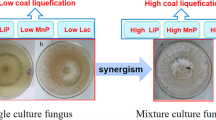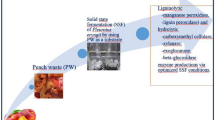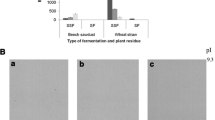Abstract
Biological pretreatment of the lignocellulosic residues, in which white-rot fungi have a crucial role, has many advantages compared to the chemical, physical, and physico-chemical methods of delignification and therefore attracts increasing scientific attention. Regarding the fact that properties and capacities of the ligninolytic enzymes of Daedaleopsis spp. are still unknown, the aim of this study was to research how nitrogen sources and inducers affect the potential of Daedaleopsis confragosa and Daedaleopsis tricolor to degrade cherry sawdust. NH4NO3, (NH4)2SO4, and peptone were tested as nitrogen sources, while veratryl alcohol, p-anisidine, vanillic acid, and phenylmethylsulfonyl fluoride were the studied inducers. As Mn-dependent peroxidase and laccase were the leader enzymes and cherry sawdust/peptone medium the best stimulator of their activities, the effect of inducers on delignification potential of these species was studied during fermentation of that substrate. Veratryl alcohol was the best stimulator of laccase and phenylmethylsulfonyl fluoride of Mn-dependent peroxidase activity (27,610.0 and 1338.4 U/L, respectively). These inducers also increased cherry sawdust delignification selectivity, particularly in D. tricolor in the presence of phenylmethylsulfonyl fluoride (lignin:hemicellulose:cellulose = 32.1%:0.9%:11.7%). Owing to the presented results, studied species could have an important role in the phase of lignocellulose pretreatment in various biotechnological processes.




Similar content being viewed by others
References
Alavanja, M. C. R. (2009). Reviews on Environmental Health, 24, 303–309.
Gupta, A., & Verma, J. P. (2015). Sustainable bio-ethanol production from agro-residues: A review. Renewable and Sustainable Energy Reviews, 41, 550–567.
Nigam, P. S., & Singh, A. (2011). Production of liquid biofuels from renewable resources. Progress in Energy and Combustion Science, 37(1), 52–68.
Stajić, M., Vukojević, J., Milovanović, I., Ćilerdžić, J., & Knežević, A. (2016). In V. K. Gupta (Ed.), Microbial enzymes in bioconversion of biomass (pp. 251–269). Switzerland: Springer International Publishing.
Galhaup, C., & Haltrich, D. (2001). Enhanced formation of laccase activity by the white-rot fungus Trametes pubescens in the presence of copper. Applied Microbiology and Biotechnology, 56(1-2), 225–232.
Silva, C. M. M. S., Soares de Melo, I., & Roberto de Oliveira, P. (2005). Enzyme and Microbial Technology, 37, 324–329.
Hakala, T. K., Hildén, K., Maijala, P., Olsson, C., & Hatakka, A. (2006). Differential regulation of manganese peroxidases and characterization of two variable MnP encoding genes in the white-rot fungus Physisporinus rivulosus. Applied Microbiology and Biotechnology, 73(4), 839–849.
Stajić, M., Persky, L., Friesem, D., Hadar, Y., Wasser, S. P., Nevo, E., & Vukojević, J. (2006). Effect of different carbon and nitrogen sources on laccase and peroxidases production by selected Pleurotus species. Enzyme and Microbial Technology, 38(1-2), 65–73.
Malarczyk, E., Rdest, J. K., & Wilkolazka, A. J. (2009). Influence of very low doses of mediators on fungal laccase activity - nonlinearity beyond imagination. Nonlinear Biomedical Physics, 3(1), 10.
Patrick, F., Mtui, G., Manoni, A., & Kivaisi, M. A. (2011). African Journal of Biotechnology, 10, 10166–10177.
Wan, C., & Li, Y. (2012). Fungal pretreatment of lignocellulosic biomass. Biotechnology Advances, 30(6), 1447–1457.
Kaal, J. E. E., Field, A. J., & Joyce, W. T. (1995). Increasing ligninolytic enzyme activities in several white-rot Basidiomycetes by nitrogen-sufficient media. Bioresource Technology, 53(2), 133–139.
Dong, J. L., Zhang, Y. W., Zhang, R. H., Huang, W. Z., & Zhang, Y. Z. (2005). Influence of culture conditions on laccase production and isozyme patterns in the white-rot fungusTrametes gallica. Journal of Basic Microbiology, 45(3), 190–198.
Mikiashvili, N., Wasser, S. P., Nevo, E., & Elisashvili, V. (2006). World Journal of Microbiology and Biotechnology, 22(9), 999–1002.
Levin, L., Melignani, E., & Ramos, A. M. (2010). Effect of nitrogen sources and vitamins on ligninolytic enzyme production by some white-rot fungi. Dye decolorization by selected culture filtrates. Bioresource Technology, 101(12), 4554–4563.
Hammel, E. K. (1997). In G. Cadisch & K. E. Giller (Eds.), Driven by nature: plant litter quality and decomposition (pp. 33–45). United Kingdom: CAB INTERNATIONAL.
Master, T., & Field, A. T. (1998). Characterization of a novel manganese peroxidase-lignin peroxidase hybrid isozyme produced by Bjerkandera species strain BOS55 in the absence of manganese. The Journal of Biological Chemistry, 273(25), 15412–15417.
Sethuraman, A., Akin, D. E., & Eriksson, K. E. L. (1999). Production of ligninolytic enzymes and synthetic lignin mineralization by the bird's nest fungus Cyathus stercoreus. Applied Microbiology and Biotechnology, 52(5), 689–697.
Songulashvili, G., Elisashvili, V., Wasser, S. P., Nevo, E., & Hadar, Y. (2006). Laccase and manganese peroxidase activities of Phellinus robustus and Ganoderma adspersum grown on food industry wastes in submerged fermentation. Biotechnology Letters, 28(18), 1425–1429.
D’Souza, T. M., Boominathan, K., & Reddy, C. A. (1996). Appl Environmental Microbiology, 62, 3739–3744.
D’Souza, T. M., Merritt, C. S., & Reddy, C. A. (1999). Appl Environmental Microbiology, 65, 5307–5313.
Tekere, M., Zvauya, R., & Read, J. S. (2001). Ligninolytic enzyme production in selected sub-tropical white rot fungi under different culture conditions. Journal of Basic Microbiology, 41(2), 115–129.
Li, P., Wang, H., Liu, G., Li, X., & Yao, J. (2011). Enzyme and Microbial Technology, 48, 1–6.
Blanchette, R. A., Krueger, E. W., Haight, J. E., Akhtar, M., & Akin, D. E. (1997). Cell wall alterations in loblolly pine wood decayed by the white-rot fungus, Ceriporiopsis subvermispora. Journal of Biotechnology, 53(2-3), 203–213.
Goodell, B., Jellison, J., Liu, J., Daniel, G., Paszczynski, A., Fekete, F., Krishnamurthy, S., Jun, L., & Xu, G. (1997). Journal of Biotechnology 53, 133–162, Low molecular weight chelators and phenolic compounds isolated from wood decay fungi and their role in the fungal biodegradation of wood1
Elisashvili, V., & Kachlishvili, E. (2009). Physiological regulation of laccase and manganese peroxidase production by white-rot Basidiomycetes. Journal of Biotechnology, 144(1), 37–42.
Knežević, A., Stajić, M., Jovanović, V., Ćilerdžić, J., Milovanović, I., & Vukojević, J. (2016). Induction of wheat straw delignification by Trametes species. Scientific Reports, 6(1), 26529.
Stelzer, R. S., Heffernan, J., & Likens, G. E. (2003). The influence of dissolved nutrients and particulate organic matter quality on microbial respiration and biomass in a forest stream. Freshwater Biology, 48(11), 1925–1937.
Bilandzija, N., Voca, N., Kricka, T., Matin, A., & Jurisic, V. (2012). Spanish Journal of Agricultural Research, 10, 292–298.
Jasinskas, A., Kocinskas, V., Jotautiene, E., & Ziemelis, I. (2017). Proceedings of 16th International scientific conference - engineering for rural development, Latvia, pp. 641–646.
Rösecke, J., & König, W. A. (2000). Constituents of the fungi Daedalea quercina and Daedaleopsis confragosa var. tricolor. Phytochemistry, 54(8), 757–762.
Bernicchia, A., Fugazzola, M. A., Gemelli, V., Mantovani, B., Lucchetti, A., Cesari, M., & Speroni, E. (2006). DNA recovered and sequenced from an almost 7000 y-old Neolithic polypore, Daedaleopsis tricolor. Mycological Research, 110(1), 14–17.
White, T. J., Bruns, T., Lee, S., & Taylor, J. (1990). In M. A. Innis, D. H. Gelfand, J. J. Sninsky, & T. J. White (Eds.), PCR protocols: a guide to methods and applications (pp. 315–322). San Diego: Academic Press.
Stajić, M., Kukavica, B., Vukojević, J., Simonić, J., Veljović-Jovanović, S., & Duletić-Laušević, S. (2010). Bioresources, 5, 2362–2373.
Stajić, M., Ćilerdžić, J., Galić, M., Ivanović, Ž., & Vukojević, J. (2017). Bioresources, 12, 7195–7204.
Ćilerdžić, J., Stajić, M., & Vukojević, J. (2016). Degradation of wheat straw and oak sawdust by Ganoderma applanatum. International Biodeterioration & Biodegradation, 114, 39–44.
Van Soest, P. J., Robertson, J. B., & Lewis, B. A. (1991). Journal of Dairy Science 74, 3583–3597,
Kirk, T. K., & Obst, J. R. (1988). In S. P. Colowick & N. O. Kaplan (Eds.), In methods in enzymology 161 (pp. 87–101). San Diego: Academic Press Inc.
Songulashvili, G., Elisashvili, V., Wasser, S. P., Nevo, E., & Hadar, Y. (2007). Enzyme and Microbial Technology, 41, 57–61.
Li, P., Wang, H., Liu, G., Li, X., & Yao, J. (2011). Enzyme and Microbial Technology, 48, 1–6.
Xavier, R. B., Maria, A., Tavares Mora, A. P., Ferreira, R., & Amado, F. (2007). Electronic Journal of Biotechnology, 10, 444–451.
Galhaup, C., Wagner, H., Hinterstoisser, B., & Haltrich, D. (2002). Enzyme and Microbial Technology, 30, 529–536.
Bakkiyaraj, S., Aravindan, R., Arrivukkarasan, S., & Viruthagiri, T. (2013). International Journal of ChemTech Research, 5, 1224–1238.
Kapich, A. N., Prior, B. A., Botha, A., Galkin, S., Lundell, T., & Hatakka, A. (2004). Enzyme and Microbial Technology, 34, 187–195.
Fukasawa, Y., Osono, T., & Takeda, H. (2005). Decomposition of Japanese beech wood by diverse fungi isolated from a cool temperate deciduous forest. Mycoscience, 46(2), 97–101.
Knežević, A., Milovanović, I., Stajić, M., Lončar, N., Brčeski, I., Vukojević, J., & Ćilerdžić, J. (2013). Lignin degradation by selected fungal species. Bioresource Technology, 138, 117–123.
Valmaseda, M., Martínez, M. J., & Martínez, A. T. (1991). Applied Microbiology and Biotechnology, 35, 817–823.
Hammel, K. E., Kapich, A. N., Jensen, K. A., & Ryan, Z. C. (2002). Enzyme and Microbial Technology, 30, 445–453.
Robertson, S. A., Mason, S. L., Hack, E., & Abbott, G. D. (2008). A comparison of lignin oxidation, enzymatic activity and fungal growth during white-rot decay of wheat straw. Organic Geochemistry, 39(8), 945–951.
Acknowledgments
This study was carried out under Project No. 173032, which is financially supported by the Ministry of Education, Science and Technological Development of Republic of Serbia.
Author information
Authors and Affiliations
Corresponding author
Ethics declarations
Conflict of Interest
The authors declare that they have no conflict of interest.
Rights and permissions
About this article
Cite this article
Ćilerdžić, J., Galić, M., Ivanović, Ž. et al. Stimulation of Wood Degradation by Daedaleopsis confragosa and D. tricolor. Appl Biochem Biotechnol 187, 1371–1383 (2019). https://doi.org/10.1007/s12010-018-2884-2
Received:
Accepted:
Published:
Issue Date:
DOI: https://doi.org/10.1007/s12010-018-2884-2




